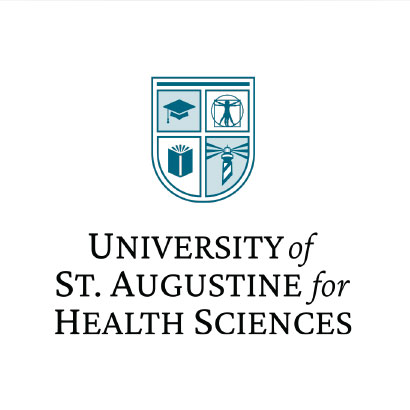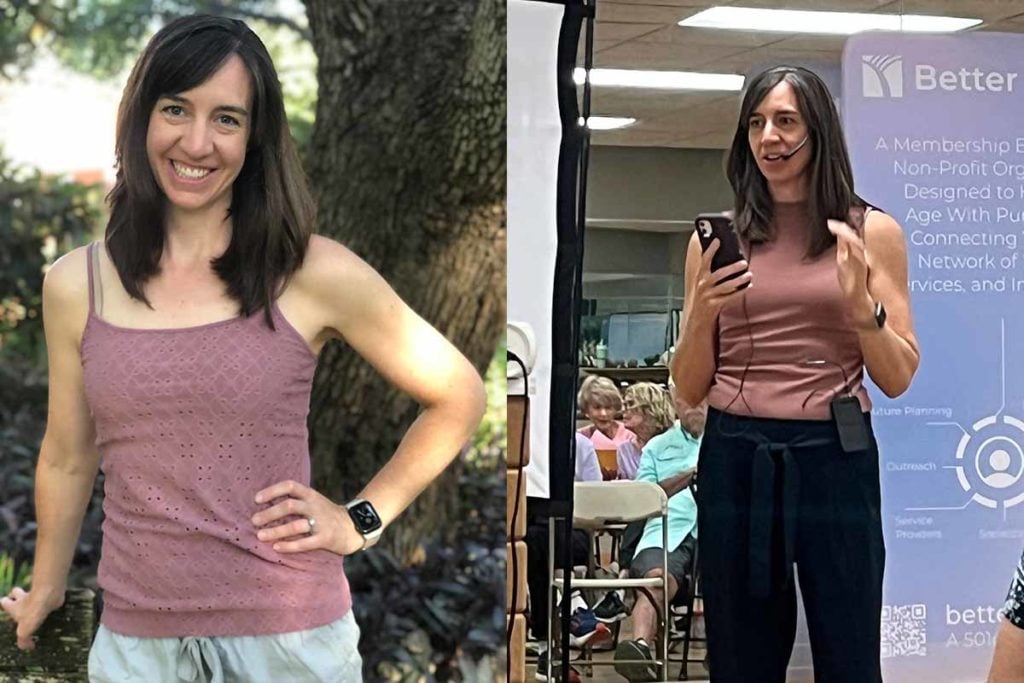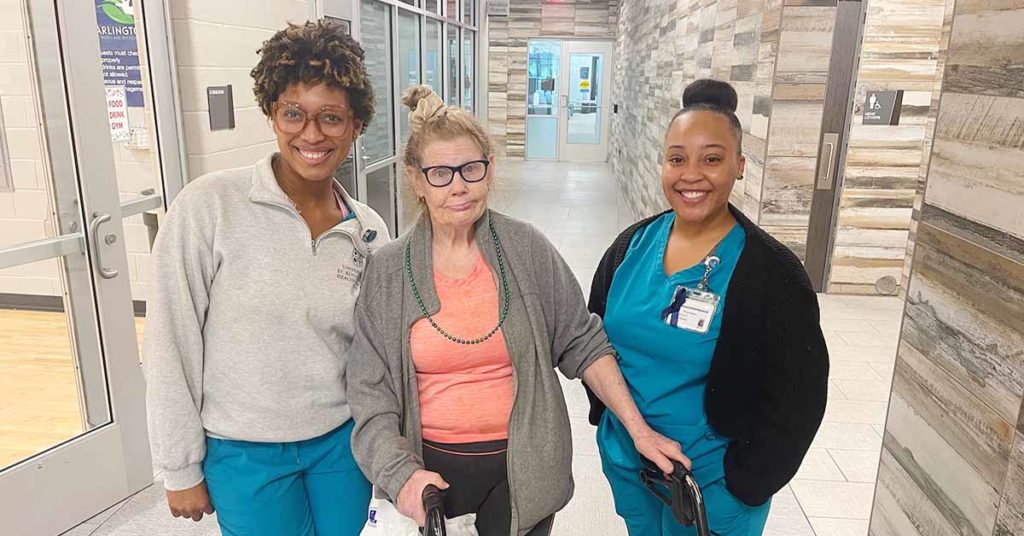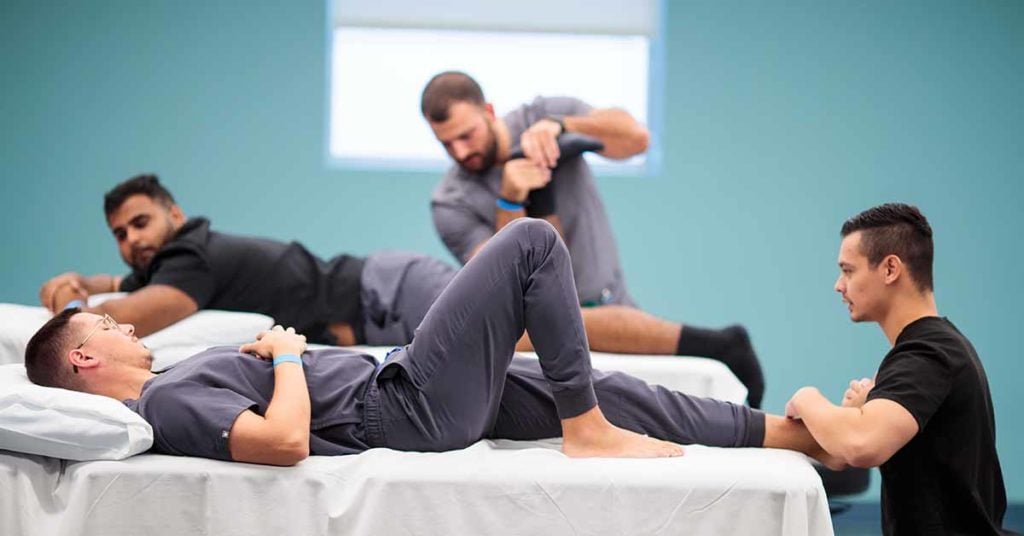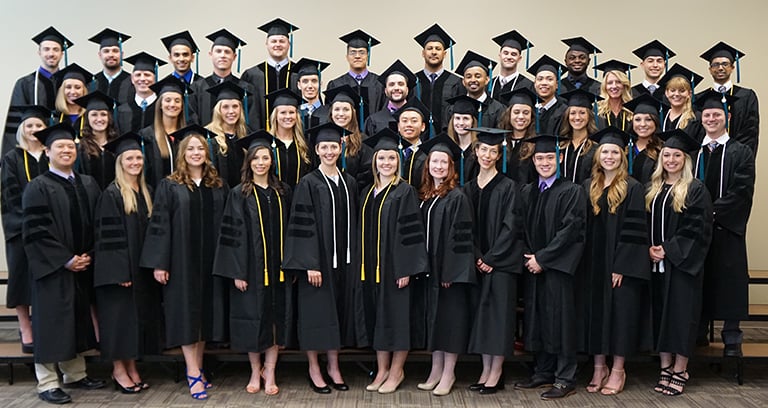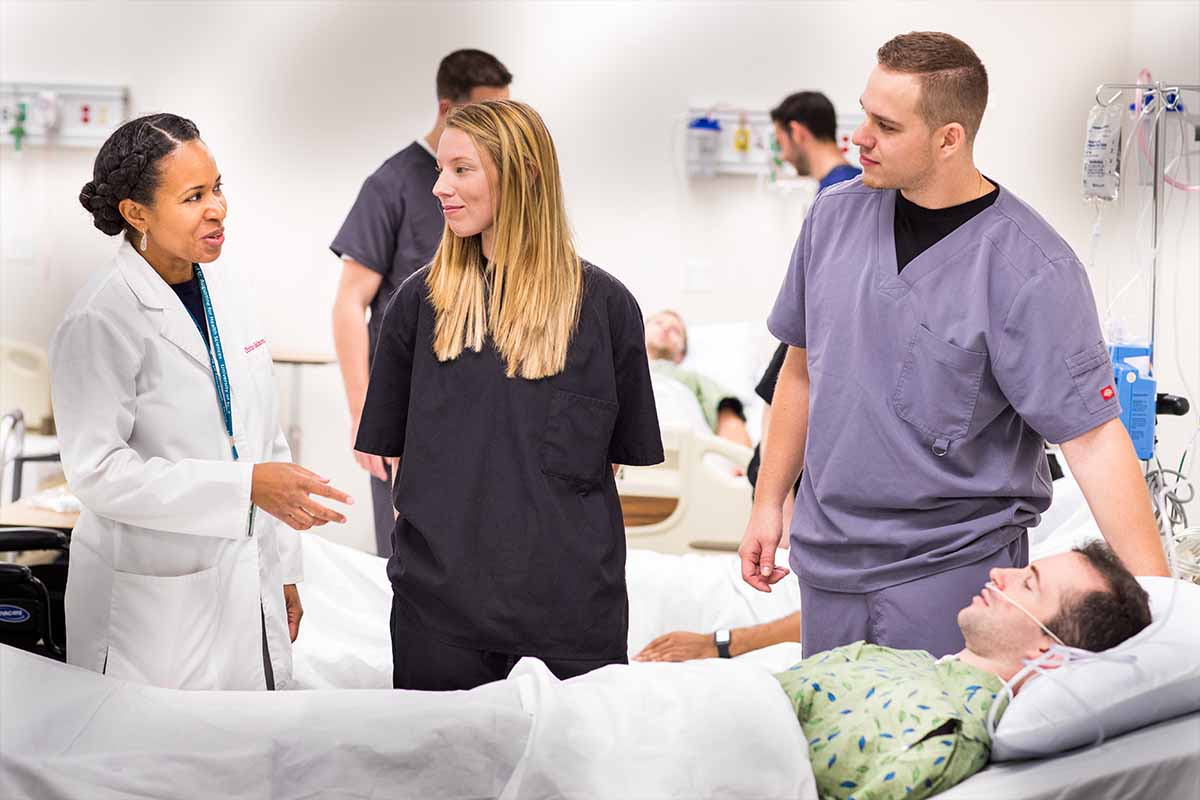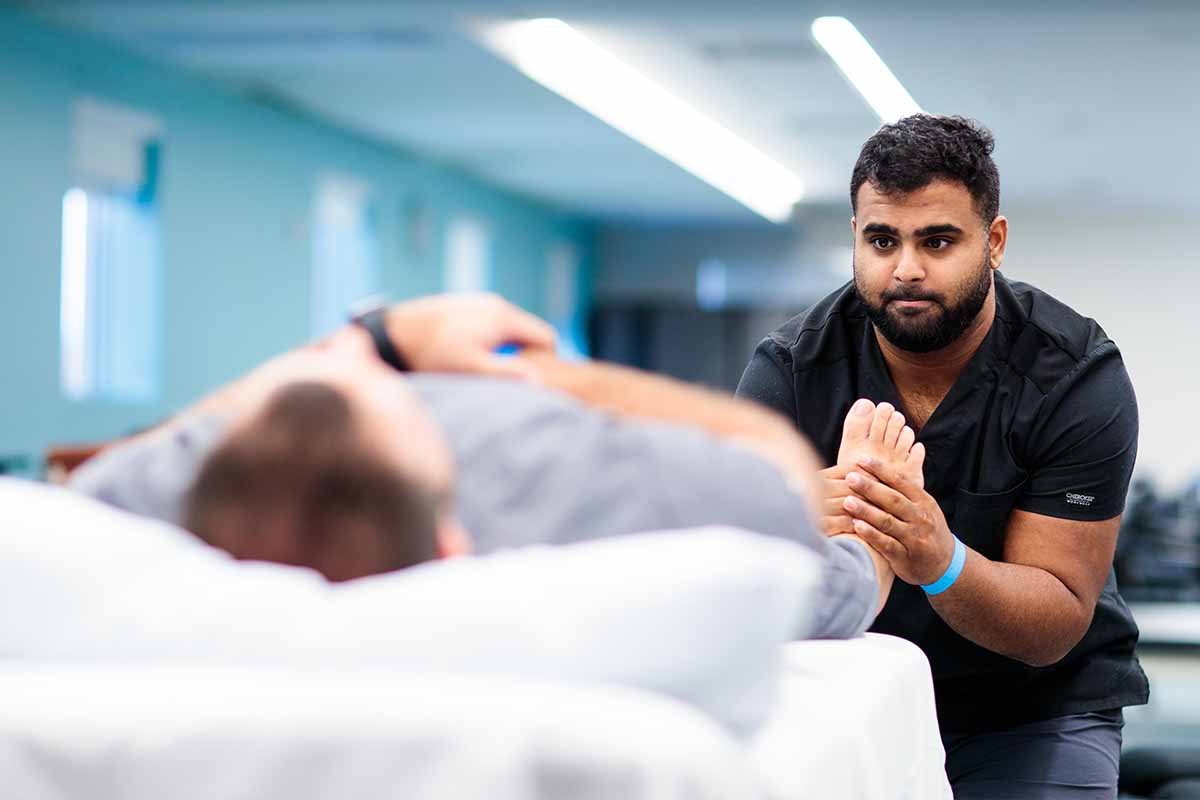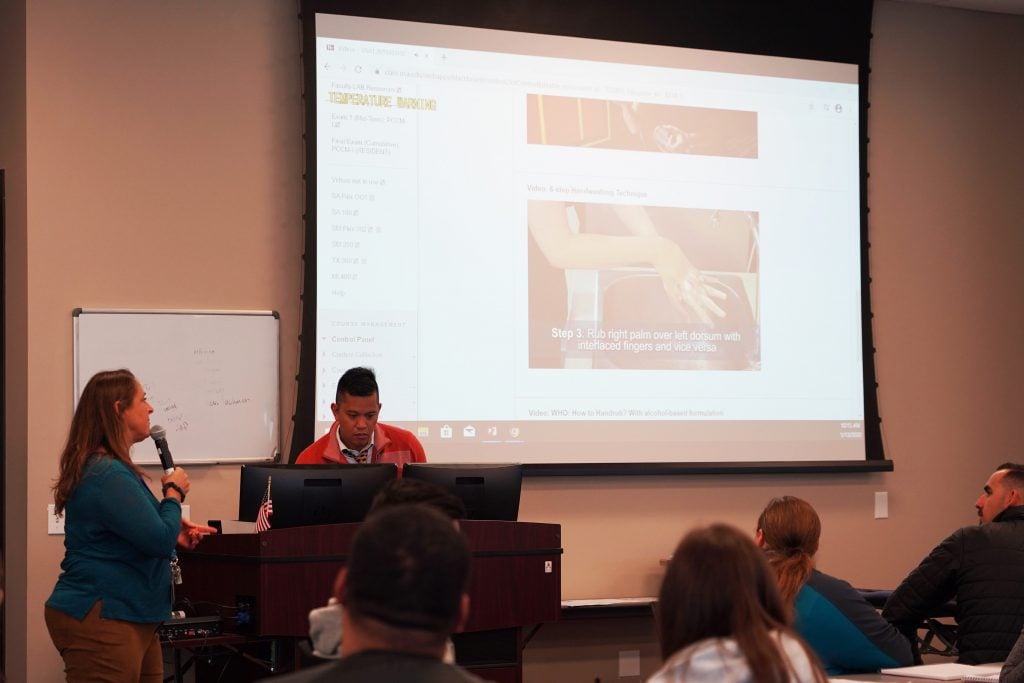

Solving puzzles, reviewing charts, communicating with patients, practicing clinical skills. At USAHS, our physical therapy and occupational therapy students work together in our simulation labs right away. Interprofessional simulations are part of Patient/Client Care Management 1 (PCCM-1), a first-trimester core course for the Residential DPT, OTD, and MOT programs on all campuses.
“From Day One of grad school at 9 a.m., our PT and OT students are elbow to elbow,” says Maureen Johnson, PhD, MS, OT/L, BCPR, C/NDT, an assistant professor of OT known as “Dr. Mo.” She co-developed this course on the San Marcos campus together with her PT colleague, assistant professor Norman Belleza, PT, DPT.
“We’ve built this course over the past five years or so, each representing our profession, with a lot of creativity,” Dr. Belleza says. “All the activities scaffold together.” Each activity is also mapped to a core competency identified by the Interprofessional Education Collaborative (IPEC).
Students in their course have the chance to work in the Center for Innovative Clinical Practice (CICP) on our San Marcos campus—our first and largest state-of-the-art simulation lab, with 16 hospital beds and a mock home setting. USAHS is one of only a few schools in the country with simulation labs dedicated to the rehabilitative sciences.
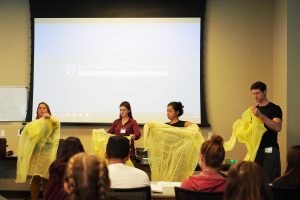

Roles and Teamwork
The first class activity focuses on interprofessional roles and responsibilities. Students work in teams on a scavenger hunt to match pieces of OT and PT equipment with their technical terms. “Everyone has a role on the team,” says Dr. Belleza. “We’re building knowledge together early—before students even know their own profession. But we’ve found this is better than putting the students together a year into their programs.”
The second activity, about teams and teamwork, features a mock patient (a manikin) who has recently undergone knee surgery. PT and OT students review the patient’s medical chart together, discuss goals specific to their disciplines, and plan co-treatment strategies. Their interactions are videotaped, and the whole class debriefs about how the students responded: what they did well and what they could do differently. Says a DPT student, “Although I was not participating as a PT actor, being able to watch [this activity] in real time was extremely beneficial.”
Between the interprofessional labs, the students study the same topics—such as bed mobility, transfers, and gait training—in separate groups. Dr. Mo explains, “The PTs will spend time training the patient how to transfer independently with proper technique and safety. The OTs will help the patient transfer, using the same principles—but then focus on retraining the patient in how to take care of themselves again (grooming, dressing, bathing, working, playing, dancing).” The point is not for PTs and OTs to learn each other’s skills—but to know when to bring the other in.
“The model of together, discipline-specific, and together again works well for the course and for learning,” Dr. Belleza says.
Communication and Ethics
The first simulation falls midway through the trimester and focuses on interprofessional communication. This time, an actor plays the mock patient. She has a wound (which is moulage, a mock injury) that is wet, and she brings this to the attention of the PT and OT. The therapists de-escalate her anxiety and bring in another interprofessional colleague, a nurse, to change the dressing. They then move forward with a co-created treatment plan according to their respective roles.
A student in the course discussed the dynamics of this exercise. “When the OT student disagreed with a decision of the PT student (that the bleeding bandage looked OK), they did so respectfully in a way that didn’t put them down and didn’t give the patient any sense of inter-professional contradiction.”
Dr. Belleza notes that in the early years of this course, students tended to compete with each other, but in recent years they’ve entered into it with a more collaborative spirit, raising each other up. Dr. Mo adds, “Some students need to bring their ego down, and some need to bring their ego up to be team players.”
In the second simulation, about values and ethics, an older woman patient becomes anxious when two male therapists walk in. She covers herself with her blanket, asking to work with women. The therapists have to decide how to handle this cultural situation. During handling, the students realize the importance of managing lines, such as the IV and Foley catheter, while transferring the patient from the bed to the wheelchair.
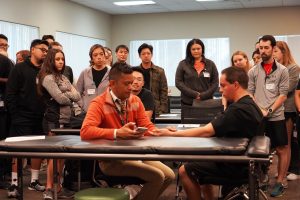

Thought Leaders in This Space
In January 2020 at the International Meeting for Simulation in Healthcare (IMSH) in San Diego, Dr. Belleza and Dr. Mo gave a presentation about their class. Says Dr. Belleza, “Can you imagine nurses, surgeons, and MDs—as well as speech therapists and respiratory therapists—going through our scavenger hunt and escape room experience just like our first-term students? It was a lot of fun seeing this carried out at the conference.”
They shared tips for how other healthcare educators can implement IPE in their school or clinical setting. Their presentation received enthusiastic feedback and helped to reinforce USAHS’s reputation as a thought leader in interprofessional simulation.
Student surveys taken before and after the course report a statistically significant increase in IPEC competency and confidence levels. Fieldwork coordinators have remarked on how well our students work in interprofessional teams. And this class continues to be a dynamic experience for the teachers as well as the students. Dr. Belleza says, “I learn more about Mo’s profession every day.”
PCCM-1 is just one example of an interprofessional course at USAHS. Stay tuned for more posts about our other IPE initiatives!
